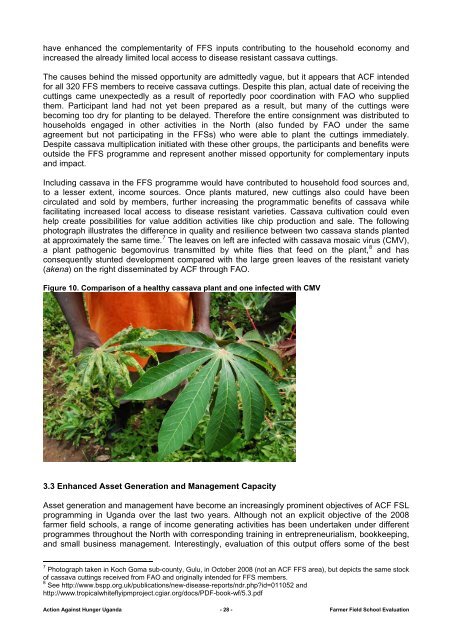Participatory Evaluation of our 2008 - Action Against Hunger
Participatory Evaluation of our 2008 - Action Against Hunger
Participatory Evaluation of our 2008 - Action Against Hunger
You also want an ePaper? Increase the reach of your titles
YUMPU automatically turns print PDFs into web optimized ePapers that Google loves.
have enhanced the complementarity <strong>of</strong> FFS inputs contributing to the household economy and<br />
increased the already limited local access to disease resistant cassava cuttings.<br />
The causes behind the missed opportunity are admittedly vague, but it appears that ACF intended<br />
for all 320 FFS members to receive cassava cuttings. Despite this plan, actual date <strong>of</strong> receiving the<br />
cuttings came unexpectedly as a result <strong>of</strong> reportedly poor coordination with FAO who supplied<br />
them. Participant land had not yet been prepared as a result, but many <strong>of</strong> the cuttings were<br />
becoming too dry for planting to be delayed. Therefore the entire consignment was distributed to<br />
households engaged in other activities in the North (also funded by FAO under the same<br />
agreement but not participating in the FFSs) who were able to plant the cuttings immediately.<br />
Despite cassava multiplication initiated with these other groups, the participants and benefits were<br />
outside the FFS programme and represent another missed opportunity for complementary inputs<br />
and impact.<br />
Including cassava in the FFS programme would have contributed to household food s<strong>our</strong>ces and,<br />
to a lesser extent, income s<strong>our</strong>ces. Once plants matured, new cuttings also could have been<br />
circulated and sold by members, further increasing the programmatic benefits <strong>of</strong> cassava while<br />
facilitating increased local access to disease resistant varieties. Cassava cultivation could even<br />
help create possibilities for value addition activities like chip production and sale. The following<br />
photograph illustrates the difference in quality and resilience between two cassava stands planted<br />
at approximately the same time. 7 The leaves on left are infected with cassava mosaic virus (CMV),<br />
a plant pathogenic begomovirus transmitted by white flies that feed on the plant, 8 and has<br />
consequently stunted development compared with the large green leaves <strong>of</strong> the resistant variety<br />
(akena) on the right disseminated by ACF through FAO.<br />
Figure 10. Comparison <strong>of</strong> a healthy cassava plant and one infected with CMV<br />
3.3 Enhanced Asset Generation and Management Capacity<br />
Asset generation and management have become an increasingly prominent objectives <strong>of</strong> ACF FSL<br />
programming in Uganda over the last two years. Although not an explicit objective <strong>of</strong> the <strong>2008</strong><br />
farmer field schools, a range <strong>of</strong> income generating activities has been undertaken under different<br />
programmes throughout the North with corresponding training in entrepreneurialism, bookkeeping,<br />
and small business management. Interestingly, evaluation <strong>of</strong> this output <strong>of</strong>fers some <strong>of</strong> the best<br />
7 Photograph taken in Koch Goma sub-county, Gulu, in October <strong>2008</strong> (not an ACF FFS area), but depicts the same stock<br />
<strong>of</strong> cassava cuttings received from FAO and originally intended for FFS members.<br />
8 See http://www.bspp.org.uk/publications/new-disease-reports/ndr.php?id=011052 and<br />
http://www.tropicalwhiteflyipmproject.cgiar.org/docs/PDF-book-wf/5.3.pdf<br />
<strong>Action</strong> <strong>Against</strong> <strong>Hunger</strong> Uganda - 28 - Farmer Field School <strong>Evaluation</strong>

















